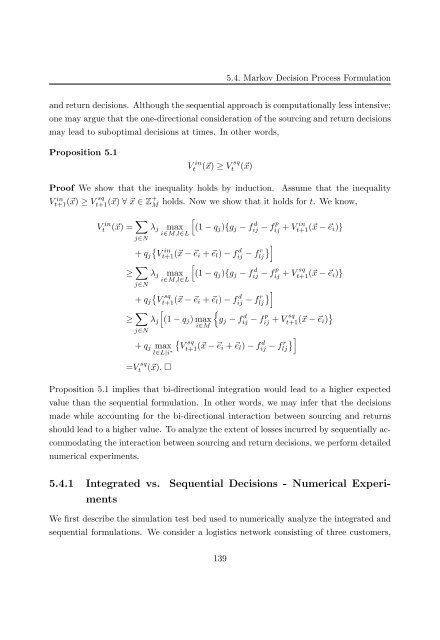Customer Information Driven After Sales Service ... - RePub
Customer Information Driven After Sales Service ... - RePub
Customer Information Driven After Sales Service ... - RePub
You also want an ePaper? Increase the reach of your titles
YUMPU automatically turns print PDFs into web optimized ePapers that Google loves.
5.4. Markov Decision Process Formulation<br />
and return decisions. Although the sequential approach is computationally less intensive;<br />
one may argue that the one-directional consideration of the sourcing and return decisions<br />
may lead to suboptimal decisions at times. In other words,<br />
Proposition 5.1<br />
V in<br />
t (�x) ≥ V sq<br />
t (�x)<br />
Proof We show that the inequality holds by induction. Assume that the inequality<br />
V in<br />
t+1(�x) ≥ V sq<br />
t+1 (�x) ∀ �x ∈ Z+<br />
M holds. Now we show that it holds for t. Weknow,<br />
V in<br />
t (�x) = � �<br />
λj max (1 − qj){gj − f<br />
i∈M,l∈L<br />
j∈N<br />
d ij − f p in<br />
ij + Vt+1(�x − �ei)}<br />
� in<br />
+ qj Vt+1(�x − �ei + �el) − f d ij − f r �<br />
lj<br />
�<br />
≥ � �<br />
λj max (1 − qj){gj − f<br />
i∈M,l∈L<br />
j∈N<br />
d ij − f p sq<br />
ij + Vt+1 (�x − �ei)}<br />
� sq<br />
+ qj Vt+1 (�x − �ei + �el) − f d ij − f r �<br />
lj<br />
�<br />
≥ � �<br />
�<br />
λj (1 − qj)max gj − f<br />
i∈M<br />
j∈N<br />
d ij − f p sq �<br />
ij + Vt+1 (�x − �ei)<br />
+ qj max<br />
l∈L|i∗ � sq<br />
Vt+1 (�x − �ei + �el) − f d ij − f r �<br />
lj<br />
�<br />
=V sq<br />
t (�x). �<br />
Proposition 5.1 implies that bi-directional integration would lead to a higher expected<br />
value than the sequential formulation. In other words, we may infer that the decisions<br />
made while accounting for the bi-directional interaction between sourcing and returns<br />
should lead to a higher value. To analyze the extent of losses incurred by sequentially accommodating<br />
the interaction between sourcing and return decisions, we perform detailed<br />
numerical experiments.<br />
5.4.1 Integrated vs.<br />
ments<br />
Sequential Decisions - Numerical Experi-<br />
We first describe the simulation test bed used to numerically analyze the integrated and<br />
sequential formulations. We consider a logistics network consisting of three customers,<br />
139

















